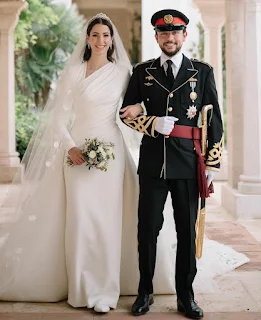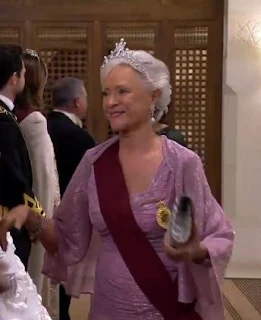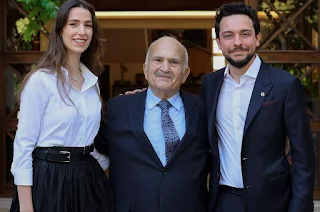On June 1, 2023, the royal wedding of the year (2023) was held in Amman, Jordan, when Crown Prince Hussein wed Rajwa Al Saif, a Saudi Arabian architect, and a distant cousin of the reigning Saudi Arabian monarch, King Salman.
The wedding was attended by who's who in the royal world - Sultan Hassanal Bolkiah of Brunei, King Philippe of Belgium, King Willem-Alexander and Queen Maxima of The Netherlands, Queen Jetsun Pema of Bhutan, The Prince and Princess of Wales, Crown Princess Victoria of Sweden and Prince Daniel, Crown Prince Frederik and Crown Princess Mary of Denmark, King emeritus Juan Carlos of Spain and Queen emerita of Spain, and many more.
 |
| Their Royal Highnesses Crown Prince Hussein and Princess Rajwa Al-Hussein following their wedding |
It was a glittery royal affair in Jordan followed by a white-tie wedding reception in Al Husseiniya Palace with royal guests in full court regalia and royal female guests wearing their sparkling tiaras.
Following the wedding ceremony, the Royal Hashemite Court of Jordan officially announced the new title of the bride:
“A Royal Decree was issued to bestow the title of Her Royal Highness Princess Rajwa Al Hussein on Miss Rajwa Khalid Alseif, on the occasion of her marriage to His Royal Highness Crown Prince Al Hussein"
 |
| The newlyweds at the wedding reception |
The announcement clears the confusion of people and the media about what to call Crown Prince Hussein's wife. However, this announcement also made people wonder, why is she not a Crown Princess when she is the wife of a Crown Prince?
We are used to the royal tradition in Europe where the wife of a prince automatically takes the female equivalent of his titles. If she is marrying a Crown Prince then she is automatically titled Crown Princess, such as the case of Crown Princess Mary of Denmark and Crown Princess Mette-Marit of Norway.
 |
| Princess Rajwa Al-Hussein |
But why not in Jordan?
Actually, the simple explanation of this is that in most Arab monarchies, marrying a future King does not mean his wife will automatically get the title of Queen. It needs a formal declaration from the King that his wife is the Queen Consort.
 |
| Crown Prince Hussein and Princess Rajwa at the US Congress |
For example, King Abdullah II, who ascended to the Jordanian throne on February 7, 1999, proclaimed his wife, Princess Rania, the Queen Consort on March 22, 1999.
Without King Abdullah II's formal declaration, Rania would just be called the Princess Consort. Just like King Abdullah II's mother, Princess Muna Al-Hussein.
 |
| Princess Iman, Queen Rania, and Princess Muna Al-Hussein |
Princess Muna, born Antoinette Gardiner in Suffolk, England, and a daughter of a British Army Officer, wed King Hussein of Jordan in 1961, as his second wife, four years after he divorced his first wife, Queen Dina, the mother of his eldest child, Princess Alia.
But King Hussein did not declare his second wife his Queen Consort and was only given the title Princess Muna Al-Hussein. After four children, their marriage ended in divorce in 1972. But Princess Muna retained her princess title. She did not remarry also.
 |
| Princess Muna Al-Hussein at the wedding reception of her grandson, Crown Prince Hussein |
Just three days after their divorce, King Hussein married his third wife, Alia Toukan, an Egyptian-born Jordanian flight stewardess and daughter of a Jordanian diplomat.
King Hussein declared her Queen Consort, so she was known as Queen Alia of Jordan. She bore the King two children, the eldest being Princess Haya (ex-wife of Dubai ruler, Sheikh Mohammed Al Maktoum). Queen Alia died in 1977 in a plane crash while performing a royal duty.
A year later, King Hussein married American-born Lebanese architect and Princeton University graduate, Lisa Halaby. After the wedding, she changed her name to Noor and converted to Islam. She was also declared by her husband as his Queen consort, and thus became known as Queen Noor.
In Morocco, King Mohammad VI also did not declare his wife as Queen. So all throughout their marriage, Lalla Bennani was only known as Princess Lalla Salma of Morocco with a formal title of Her Royal Highness The Princess Consort. She was also the first wife of a Moroccan King to have ever been given a royal title.
Understanding the Jordanian Succession System
The throne of Jordan, although hereditary, is different from the traditional dynastic system of Europe where automatic succession is guaranteed by the constitution to the firstborn child (in Absolute Primogeniture Succession) or the firstborn son (in Male-preference Primogeniture Succession) of the reigning monarch.
 |
| Engagement photo. Photo credit: Royal Hashemite Court |
The firstborn son of the monarch can only succeed to the Jordanian throne if the King dies without appointing a successor.
Article 28(B) of Jordan's constitution states that the monarch's eldest son automatically succeeds to the crown upon the monarch's death unless the king has designated one of his brothers to inherit the throne as crown prince.
 |
| Photo credit: Crown Prince Hussein IG |
King Abdullah II's case
Throughout his life while his father was alive, King Abdullah II, although the first-born son of King Hussein, was not the Crown Prince or heir apparent. It was his uncle, Prince El Hassan bin Talal, the younger brother of King Hussein, who was the Crown Prince and successor.
In 1965, three years after Prince Abdullah was born, King Hussein declared that his younger brother, Prince El Hassan bin Talal, would be his successor, thereby assuming the title of Crown Prince.
This is because most monarchies in the Middle East/West Asia, including Jordan, practiced the Agnatic Seniority Succession, a patrilineal principle of inheritance where the order of succession to the throne prefers the monarch's younger brother over the monarch's own sons. A monarch's children (the next generation) can only succeed after the males of the elder generation have all been exhausted.
Crown Prince Hassan assumed full responsibilities of the heir apparent in 1965. But in the late 1990s, King Hussein's health began to decline due to cancer, so he appointed the Crown Prince, as regent, to exercise a range of power and authority in Jordan.
However, Crown Prince Hassan disappointed the King when he attempted to consolidate power, leading King Hussein to strip him of the title of Crown Prince on January 24, 1999.
King Hussein then declared his firstborn son, Prince Abdullah, the new Crown Prince. On February 7, 1999, King Hussein died from cancer. The Crown Prince ascended to the Jordanian throne as King Abdullah II.
 |
| Former Crown Prince of Jordan, Prince Hassan bin Talal, with the new Crown Prince Hussein, and his fiancee, Rajwa Al Saif. October 2022 |
Despite this family discord, Prince Hassan did not bear remorse against the new King, his nephew. Over the years since King Abdullah II inherited the throne, Prince Hassan reconnected with his family and often attended royal events.
In October 2022, two months after their official engagement, Crown Prince Hussein and his fiancee, Rajwa Al Saif, made a joint royal engagement by visiting the exhibit dedicated to the Jordanian Hashemite History organized by Prince Hassan.
The former Crown Prince warmly welcomed the current Crown Prince, his great-nephew, and accompanied him and Rajwa touring the exhibit.
Crown Prince Hussein was grateful with his great-uncle accommodation, saying: "There is no one more knowledgeable than my great uncle El Hassan when it comes to Jordan's history and our Hashemite legacy, Rajwa and I had the pleasure of viewing exhibits from Jordan's Hashemite history at the Royal Hashemite Court today."
 |
| Wedding of Crown Prince Hussein with the Jordanian royal family. Prince Hassan stood next to Queen Rania. Photo credit: The Royal Hashemite Court |
Prince Hassan bin Talal also attended the wedding of Crown Prince Hussein and Princess Rajwa on June 1, 2023. All is well with this family tension, but seems not with the other former Crown Prince.
Tension between the King and the Crown Prince
On February 7, 1999, the same day that he ascended to the throne, King Abdullah II, following the principles of the Agnatic Seniority Succession, declared his younger half-brother, Prince Hamzah (son of King Hussein and his fourth wife, Queen Noor), a Harvard University graduate and officer in the Jordanian army, the new Crown Prince, instead of his eldest son, Prince Hussein, who was born in 1994.
However, in 2001, Crown Prince Hamzah and high-ranking Jordanian officials were accused of promoting sedition. According to The Washington Post, an extensive investigations were conducted by Jordan's security forces and discovered Crown Prince Hamzah and close associates had engaged in activities that amounted to "promoting sedition."
 |
| King Abdullah II (seated) with his wife, Queen Rania, and his brother, Crown Prince Hamzah |
Crown Prince Hamzah was held under house arrest but denied the accusations, saying he was being punished for speaking against corruption. King Abdullah II attempted to resolve the issue but the Crown Prince reportedly refused to cooperate.
In 2022, on the anniversary of his arrest, Crown Prince Hamzah posted on Twitter that he will step down as Crown Prince, which infuriated the King even more, saying that only him can grant and strip titles according to the Jordanian constitution.
Incensed with his brother's behavior, King Abdullah II released a royal decree restricting the movement of the Crown Prince, calling him “arrogant,” “erratic” and seditious. Adding that Hamzah “exhausted all opportunities to restore himself on the right path” and clung to delusion, believing himself to be the sole guardian of the family’s legacy.
On November 28, 2004, finally King Abdullah II, stripped Hamzah the title of Crown Prince. In a letter addressed to his brother, His Majesty said: "Your holding this symbolic position has restrained your freedom and hindered our entrusting you with certain responsibilities that you are fully qualified to undertake."
After he stripped his brother the title of Crown Prince, King Abdullah II did not name a successor. Less than five years later, on July 2, 2009, His Majesty finally declared his eldest son, Prince Hussein, who was only 15 years old at that time, the new Crown Prince.
This succession system in Jordan where the King has the power to change whoever he likes as his successor without requiring parliamentary approval (unlike in Europe where the monarch has no power to pick an heir apparent as he or she wishes), does not guarantee that the wife of the Crown Prince of Jordan is also the next Queen Consort. It is for this reason that Princess Rajwa Al-Hussein is not titled Crown Princess.
 |
| Princess Rajwa Al Hussein |
European Monarchies System
This is also the reason why the husband of Crown Princess Victoria of Sweden, Prince Daniel, is not titled Crown Prince, because he would not be king if Victoria ascends to the throne someday.
In European monarchies, the constitution does not define the role of the husband of the Queen regnant other than the prince consort. Unlike when the monarch is male, his wife will automatically become the Queen consort.
 |
| Crown Princess Victoria of Sweden, her husband, Prince Daniel, and their eldest child, Princess Estelle, attend the Birthday Gala of her godson, Prince Christian of Denmark |
And so we only hear women in European royalty being Crown Princesses when marrying Crown Princes. But no Crown Prince when marrying a Crown Princess.
It is also interesting to note that among the 20th-century Queens in Europe, only Queen Elizabeth II who did not grant her husband the title of Prince Consort. He was only known as HRH Prince Philip, The Duke of Edinburgh.
Queen Juliana and her daughter and successor Queen Beatrix of the Netherlands, and Queen Margrethe II of Denmark, granted their respective husbands the title of prince consort.








0 Comments